应用语言学要点总结
- 格式:docx
- 大小:19.70 KB
- 文档页数:3
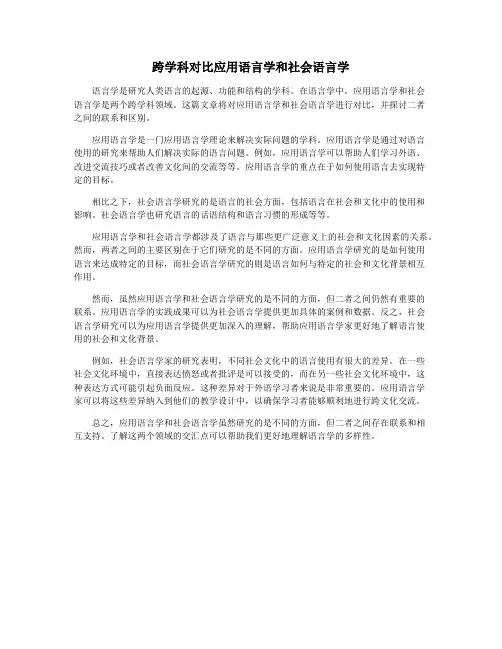
跨学科对比应用语言学和社会语言学语言学是研究人类语言的起源、功能和结构的学科。
在语言学中,应用语言学和社会语言学是两个跨学科领域。
这篇文章将对应用语言学和社会语言学进行对比,并探讨二者之间的联系和区别。
应用语言学是一门应用语言学理论来解决实际问题的学科。
应用语言学是通过对语言使用的研究来帮助人们解决实际的语言问题。
例如,应用语言学可以帮助人们学习外语、改进交流技巧或者改善文化间的交流等等。
应用语言学的重点在于如何使用语言去实现特定的目标。
相比之下,社会语言学研究的是语言的社会方面,包括语言在社会和文化中的使用和影响。
社会语言学也研究语言的话语结构和语言习惯的形成等等。
应用语言学和社会语言学都涉及了语言与那些更广泛意义上的社会和文化因素的关系。
然而,两者之间的主要区别在于它们研究的是不同的方面。
应用语言学研究的是如何使用语言来达成特定的目标,而社会语言学研究的则是语言如何与特定的社会和文化背景相互作用。
然而,虽然应用语言学和社会语言学研究的是不同的方面,但二者之间仍然有重要的联系。
应用语言学的实践成果可以为社会语言学提供更加具体的案例和数据。
反之,社会语言学研究可以为应用语言学提供更加深入的理解,帮助应用语言学家更好地了解语言使用的社会和文化背景。
例如,社会语言学家的研究表明,不同社会文化中的语言使用有很大的差异。
在一些社会文化环境中,直接表达愤怒或者批评是可以接受的,而在另一些社会文化环境中,这种表达方式可能引起负面反应。
这种差异对于外语学习者来说是非常重要的。
应用语言学家可以将这些差异纳入到他们的教学设计中,以确保学习者能够顺利地进行跨文化交流。
总之,应用语言学和社会语言学虽然研究的是不同的方面,但二者之间存在联系和相互支持。
了解这两个领域的交汇点可以帮助我们更好地理解语言学的多样性。
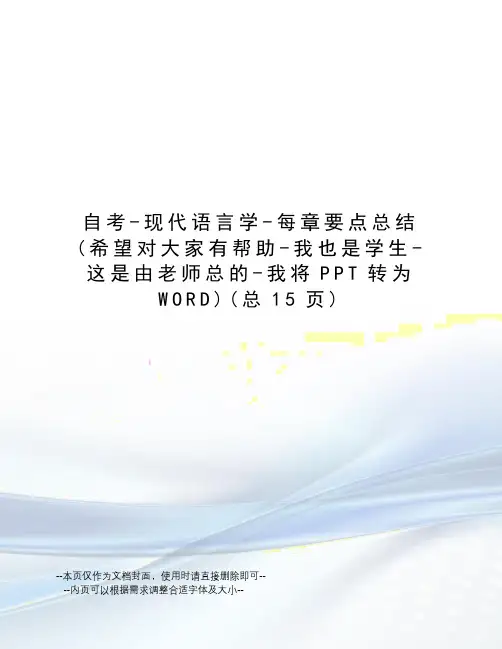
自考-现代语言学-每章要点总结(希望对大家有帮助-我也是学生-这是由老师总的-我将P P T转为W O R D)(总15页)--本页仅作为文档封面,使用时请直接删除即可----内页可以根据需求调整合适字体及大小--第一章绪论1/ What is linguistics 什么是语言学?Linguistics is generally defined as the scientific study of language. It studies not any particular language, but languages in general. 2/ The scope oflinguistics语言学的研究范畴The study of language as a whole is oftencalled general linguistics. (普通语言学)The study of sounds, which are used inlinguistic communication, is called phonetics. (语音学)The study of how sounds are put together and used in communication is called phonology. (音系学)The study of the way in which morphemes are arranged to form words are called morphology. (形态学)The study of how morphemes and words are combined to form sentences is called syntax. (句法学)The study of meaning in language iscalled semantics. (语义学)The study of meaning in context of use iscalled pragmatics. (语用学)The study of language with reference to society is called socio-linguistics. (社会语言学)The study of language with reference to the working of mind is called psycho-linguistics. (心理recovery of speech ability)is generally knownas applied linguistics.(应用语言学)But in a narrow sense,applied linguistics refersto the application oflinguistic principles andtheories to languageteaching and learning,especially the teaching offoreign and secondlanguage.Other related branchesinclude anthropologicallinguistics, (人类语言学)neurologicallinguistics, (神经语言学)mathematicallinguistics, (数字语言学)and computationallinguistics. (计算机语言学)3/ Some importantdistinctions inlinguistics语言学研究中的几对基本概念Prescriptive anddescriptive描写与规定If a linguistic studydescribes and analyzes thelanguage people actuallyuse, it is said tobe descriptive, if itaims to lay down rules totell people what theyshould say and what theyshould not say, it is saidto be prescriptive.Modern linguisticsdiffers from traditionalgrammar.Traditional grammar isprescriptive while modernlinguistics is descriptive.The task of linguists issupposed to describe thelanguage people actuallyuse, whether it is“correct” or not.Synchronic and diachronic共时和历时The description of alanguage at some point ina diachronic study. Inmodern linguistics,synchronic study is moreimportant.Speech and writing口头语与书面语Speech and writing arethe two major media ofcommunication.Modern linguisticsregards the spoken form oflanguage as primary, butnot the written form.Reasons:1. Speech precedeswriting;2. There are still manylanguages that have onlythe spoken form;3. In terms of function,the spoken language isused for a wider range ofpurposes than the written,and carries a larger loadof communication than thewritten.Langue and parole[pə'rəul]语言和言语The Swiss linguist F.de Saussure made thedistinction between langueand parole early20th century.Langue refers to theabstract linguistic systemshared by all the membersof a speech community,and parole refers to therealization of langue inactual use.Saussure made thedistinction in order tosingle out one aspect oflanguage for serious study.He believes what linguistsshould do is to abstractlangue from parole, todiscover the regularitiesgoverning the actual useof language and make themthe subjects of study oflinguistics.语言能力和语言运用Competence andperformanceProposed by Americanlinguist N. Chomsky in thethe ideal user’sknowledge of the rules ofhis language,and performance theactual realization of thisknowledge in linguisticcommunication. He believesthe task of the linguistsis to discover and specifythe language rules.4/ What is language语言的定义Language is a system ofarbitrary vocal symbolsused for humancommunication.Sapir,Edward uses“ideas” “emotions” and“desires” in hisdefinition.Hall, like Sapir, treatslanguage as a purely humaninstitution.Chomsky’s definition isquite different, it focuson the purely structuralproperties of languagesand to suggest that theseproperties can beinvestigated from amathematically precisepoint of view.5/ Design features语言的甄别性特征Design features refer tothe defining properties ofhuman language thatdistinguish it from anyanimal system ofcommunication.American linguistCharles Hockett specifiedtwelve design features.1) Arbitrariness任意性(和约定俗成性)It means that there isno logical connectionbetween meanings andsounds.For instance, there is nonecessary relationshipbetween the word dog andthe animal it refers to.The fact that differentsounds are used to referto the same object indifferent languages andthat the same sound may beused to refer to differentnot entirely arbitrary. Some words, such as the words created in the imitation of sounds by sounds are motivated in a certain degree. The arbitrary nature of language makes it possible for language to have an unlimited source of expressions.2) Productivity能产性Language is productive or creative in that it makes possible the construction and interpretation of an infinitely large number of sentences, including those that they have never said or heard before.3) Duality结构二重性It means that language is a system, which consists of two sets of structure, or two levels, one of sounds at the lower level and the other of meanings at the higher level. At the lower or the basic level, there is the structure of individual and meaningless sounds, which can be grouped into meaningful units at the higher level. This duality of structure or double articulation of language enables its users to talk about anything withintheir knowledge.4) Displacement语言的移位性(突破时空性)It means that language can be used to talk about what happened in the past, what is happening now, or what will happen in the future. Language can also be used to talk about our real word experiences or the experiences in our imaginary world. In other words, language can be used to refer to contexts removed from the immediate situations of the speaker. 5) Cultural transmission文化传播性While we are born withthe ability to acquirelanguage, the details ofany language are notgenetically transmitted,but instead have to betaught and learned anew.**********************************Chapter 2Phonology 音系学phonic medium of language语言的声音媒介Speech and writing arethe two media used bynatural languages asvehicles for communication.Of the two media oflanguage, speech is morebasic than writing. Speechis prior to writing. Thewriting system of anylanguage is always“invented” by its usersto record speech when theneed arises.For linguists, the studyof sounds is of greaterimportance than that ofwriting.The limited ranges ofsounds which aremeaningful in humancommunication and are ofinterest to linguisticstudies are the phonicmedium of language (语言的声音媒介) .The individual soundswithin this range are thespeech sounds (语音).2.What is phonetics什么是语音学?Phonetics is defined asthe study of the phonicmedium of language;It isconcerned with all thesounds that occur in theworld’s languages.语音学研究的对象是语言的声音媒介,即人类语言中使用的全部语音。
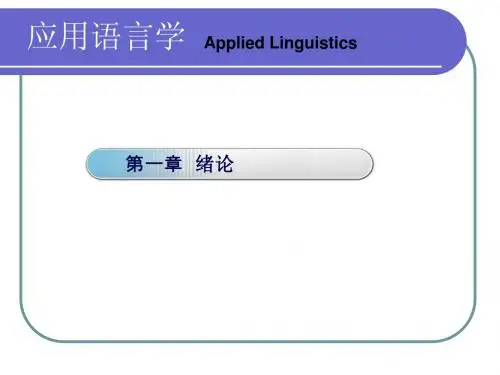
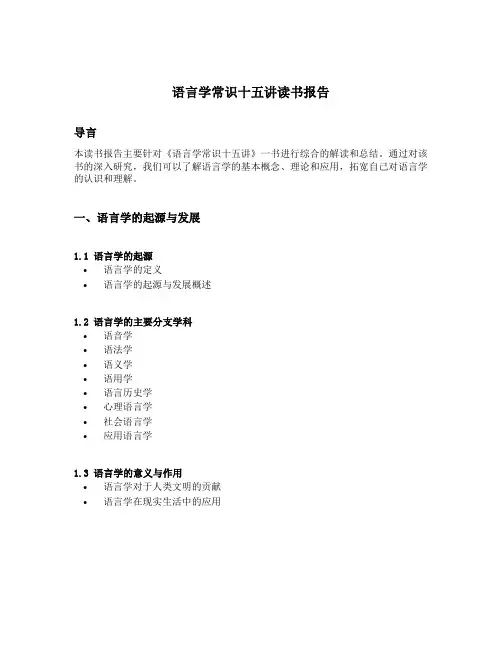
语言学常识十五讲读书报告导言本读书报告主要针对《语言学常识十五讲》一书进行综合的解读和总结。
通过对该书的深入研究,我们可以了解语言学的基本概念、理论和应用,拓宽自己对语言学的认识和理解。
一、语言学的起源与发展1.1 语言学的起源•语言学的定义•语言学的起源与发展概述1.2 语言学的主要分支学科•语音学•语法学•语义学•语用学•语言历史学•心理语言学•社会语言学•应用语言学1.3 语言学的意义与作用•语言学对于人类文明的贡献•语言学在现实生活中的应用二、语言学的基本概念与理论2.1 语言的定义与特点•语言的定义及其基本特征•人类语言与动物语言的区别2.2 语言的组成要素•语音•词汇•语法•语义•语用2.3 语言的语言能力与语言运用•语言能力的概念及其构成•语言运用的概念及其分类2.4 语言交际的相关概念•话语•信息•场景•背景知识三、语言的演化与变异3.1 语言变异的原因与表现形式•语音变异•词汇变异•语法变异•语义变异3.2 语言演化的主要模式•语言变异的原因与机制•语言变异的影响因素•语言演化的历史演变3.3 语言变异的社会文化背景•社会语言变异•文化语言变异3.4 语言变异的影响与意义•语言变异对人类文化的影响•语言变异对社会交往的影响四、语言与认知4.1 语言对思维的影响•语言与思维的关系•语言对思维的塑造作用4.2 语言对认知的影响•语言对认知的启发作用•语言对认知的限制作用4.3 语言与非语言信息处理的关系•语言与视觉信息处理的关系•语言与听觉信息处理的关系4.4 语言的学习与记忆•语言学习的认知机制•语言记忆的认知特点五、语言的多样性与一体性5.1 语言的多样性及其原因•语言的地理分布•语言的历史起源5.2 语言的一体性及其特点•语言的共性特点与规律•语言的相似性与差异性5.3 跨文化语言交际中的挑战与策略•语音理解的挑战与策略•语义理解的挑战与策略•语用理解的挑战与策略六、语言学的发展与应用前景6.1 语言学的研究热点与前沿•语言学的理论研究•语言学的实证研究6.2 语言学的应用前景与发展趋势•机器翻译的发展趋势•语音识别与语音合成的应用前景•自然语言处理的发展方向结语通过对《语言学常识十五讲》一书的深入研读,我们可以全面了解语言学的起源、发展和应用。

第一章对外汉语教育是一门专门的学科一、名词解释1.第一语言2.第二语言3.双语/多语现象4.母语5.外语6.本族语7.非本族语8.目的语9.应用语言学10.对外汉语教育的学科任务11.学科体系12.语言学13.语言学的教学14.语言学的课程15.社会学16.社会语言学17.学科定位二、填空1.按()可将语言分为第一语言和第二语言。
2.第一语言指人出生以后()的语言;第二语言指人们在获得()以后再学习和使用的另一种语言3.按()划分,可将语言分为母语和外语。
母语指()、()的语言;外语指()的语言4.按()(通常是按()的界限划分)可将语言分为本族语和非本族语5.目的语指人们()并()的语言6.从对语言的掌握程度来看,()、()、()通常是一个人的“主要语言”7.广义地说,第二语言和外语是()关系8.凡是在该语言使用的环境中学习的目的语称为();而不再其使用环境中学习的目的语被称为()9.对外汉语教育学科研究的核心内容是()10.对外汉语教育是研究汉语作为第二语言的()、()和(),并用来指导(),从而更好地实现学习者德智体美全面发展的教育目的11.学科体系是一门学科的结构系统,它显示构成该学科的()和()因素以及这些因素之间的关系。
其核心部分是()12.对外汉语教育学科体系分三个部分:()()()13.对外汉语教育学科体系基础理论包括四个方面:()()()()14.对外汉语教学是一种(),也是一种()三、简答1.“第二语言”和“外语”的区分2.对外汉语教育的学科任务3.对外汉语教学系统的内部因素和外部因素分别是4.请简介对外汉语教育的学科体系5.区分“对外汉语语言学”和“语言学”(对外汉语教学研究和汉语作为母语研究的对比)6.简述对外汉语教学的性质7.简述对外汉语教学的特点8.简述对外汉语教学的学科特点9.为什么把对外汉语教学直接称为应用语言学是不恰当地?10.如何正确体现“教学”与“教育”的关系第二章汉语作为第二语言教学的发展和现状一、填空1.我国的对外汉语教学,从1950年7月在清华大学成立第一个对外汉语教学机构“()”算起,至今已近50年。
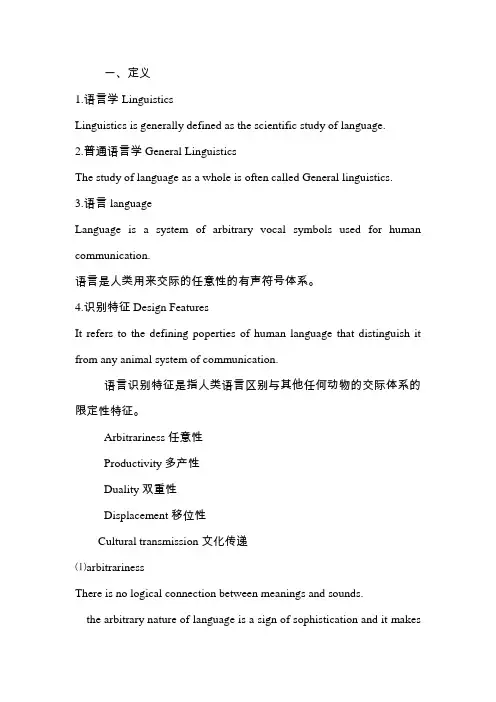
一、定义1.语言学LinguisticsLinguistics is generally defined as the scientific study of language.2.普通语言学General LinguisticsThe study of language as a whole is often called General linguistics.3.语言languageLanguage is a system of arbitrary vocal symbols used for human communication.语言是人类用来交际的任意性的有声符号体系。
4.识别特征Design FeaturesIt refers to the defining poperties of human language that distinguish it from any animal system of communication.语言识别特征是指人类语言区别与其他任何动物的交际体系的限定性特征。
Arbitrariness任意性Productivity多产性Duality双重性Displacement移位性Cultural transmission文化传递⑴arbitrarinessThere is no logical connection between meanings and sounds.the arbitrary nature of language is a sign of sophistication and it makesit possible for language to have an unlimited source of expressions⑵ProductivityAnimals are quite limited in the messages they are able to send.⑶DualityLanguage is a system, which consists of two sets of structures ,or two levels.⑷DisplacementLanguage can be used to refer to contexts removed from the immediate situations of the speaker.⑸Cultural transmissionHuman capacity for language has a genetic basis, but we have to be taught and learned the details of any language system. this showed that language is culturally transmitted. not by instinct. animals are born with the capacity to produce the set of calls peculiar to their species.5.语言能力CompetenceCompetence is the ideal user’s knowledge of the rules of his language. 6.语言运用performancePerformance is the actual realization of this knowledge in linguistic communication.语言运用是所掌握的规则在语言交际中的体现。
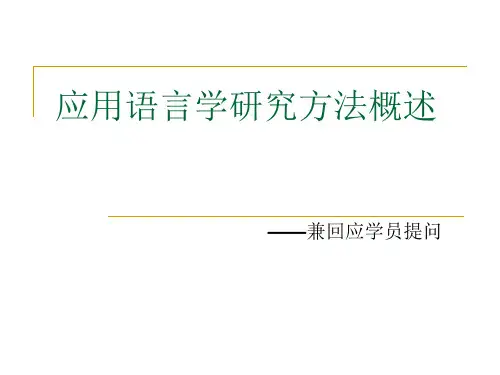
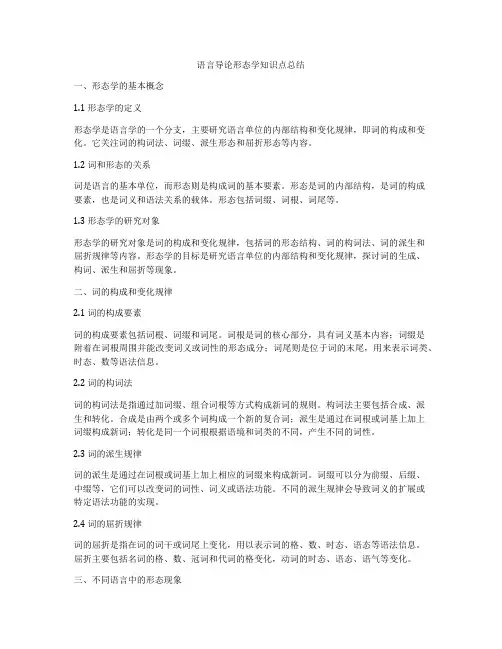
语言导论形态学知识点总结一、形态学的基本概念1.1 形态学的定义形态学是语言学的一个分支,主要研究语言单位的内部结构和变化规律,即词的构成和变化。
它关注词的构词法、词缀、派生形态和屈折形态等内容。
1.2 词和形态的关系词是语言的基本单位,而形态则是构成词的基本要素。
形态是词的内部结构,是词的构成要素,也是词义和语法关系的载体。
形态包括词缀、词根、词尾等。
1.3 形态学的研究对象形态学的研究对象是词的构成和变化规律,包括词的形态结构、词的构词法、词的派生和屈折规律等内容。
形态学的目标是研究语言单位的内部结构和变化规律,探讨词的生成、构词、派生和屈折等现象。
二、词的构成和变化规律2.1 词的构成要素词的构成要素包括词根、词缀和词尾。
词根是词的核心部分,具有词义基本内容;词缀是附着在词根周围并能改变词义或词性的形态成分;词尾则是位于词的末尾,用来表示词类、时态、数等语法信息。
2.2 词的构词法词的构词法是指通过加词缀、组合词根等方式构成新词的规则。
构词法主要包括合成、派生和转化。
合成是由两个或多个词构成一个新的复合词;派生是通过在词根或词基上加上词缀构成新词;转化是同一个词根根据语境和词类的不同,产生不同的词性。
2.3 词的派生规律词的派生是通过在词根或词基上加上相应的词缀来构成新词。
词缀可以分为前缀、后缀、中缀等,它们可以改变词的词性、词义或语法功能。
不同的派生规律会导致词义的扩展或特定语法功能的实现。
2.4 词的屈折规律词的屈折是指在词的词干或词尾上变化,用以表示词的格、数、时态、语态等语法信息。
屈折主要包括名词的格、数、冠词和代词的格变化,动词的时态、语态、语气等变化。
三、不同语言中的形态现象3.1 中国语言的形态现象汉语是一个以词汇和语序为主要特征的语言,形态变化比较简单。
汉语的词构成多采用词素的复合方式,如“书店”、“教室”等。
此外,汉语还有一些词缀和词类标志,如“了”、“的”等。
3.2 英语的形态现象英语是一种屈折语言,动词、名词、形容词等在词形上会发生变化。
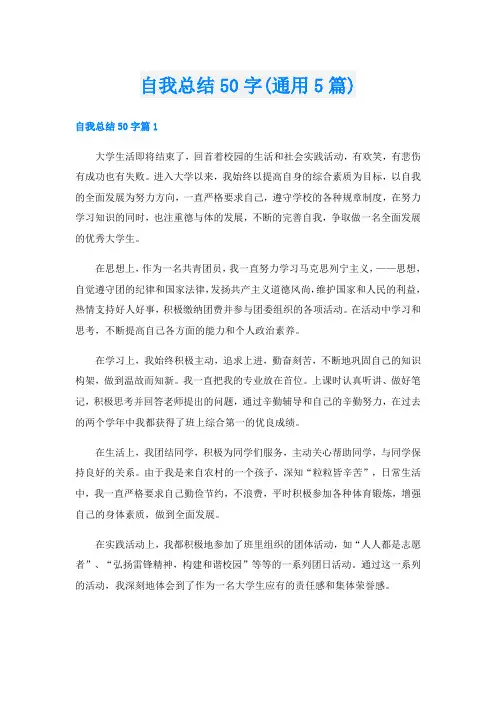
自我总结50字(通用5篇)自我总结50字篇1大学生活即将结束了,回首着校园的生活和社会实践活动,有欢笑,有悲伤有成功也有失败。
进入大学以来,我始终以提高自身的综合素质为目标,以自我的全面发展为努力方向,一直严格要求自己,遵守学校的各种规章制度,在努力学习知识的同时,也注重德与体的发展,不断的完善自我,争取做一名全面发展的优秀大学生。
在思想上,作为一名共青团员,我一直努力学习马克思列宁主义,——思想,自觉遵守团的纪律和国家法律,发扬共产主义道德风尚,维护国家和人民的利益,热情支持好人好事,积极缴纳团费并参与团委组织的各项活动。
在活动中学习和思考,不断提高自己各方面的能力和个人政治素养。
在学习上,我始终积极主动,追求上进,勤奋刻苦,不断地巩固自己的知识构架,做到温故而知新。
我一直把我的专业放在首位。
上课时认真听讲、做好笔记,积极思考并回答老师提出的问题,通过辛勤辅导和自己的辛勤努力,在过去的两个学年中我都获得了班上综合第一的优良成绩。
在生活上,我团结同学,积极为同学们服务,主动关心帮助同学,与同学保持良好的关系。
由于我是来自农村的一个孩子,深知“粒粒皆辛苦”,日常生活中,我一直严格要求自己勤俭节约,不浪费,平时积极参加各种体育锻炼,增强自己的身体素质,做到全面发展。
在实践活动上,我都积极地参加了班里组织的团体活动,如“人人都是志愿者”、“弘扬雷锋精神,构建和谐校园”等等的一系列团日活动。
通过这一系列的活动,我深刻地体会到了作为一名大学生应有的责任感和集体荣誉感。
我知道没有等出来的成功,只有走出来的辉煌。
在今后的学习生活中,我要在现在的基础上更加的努力,朝着梦想不断迈进,不断地完善自我,争做一名新时代的优秀大学生。
自我总结50字篇2在华中师范大学攻读硕士学位的两年研究生生活,是我生活压力、经济负担最重、学业收获最多的求学阶段。
在老师的关心、同学的帮助与自身的努力下,我的研究生生涯可谓是风风火火、无怨无悔。
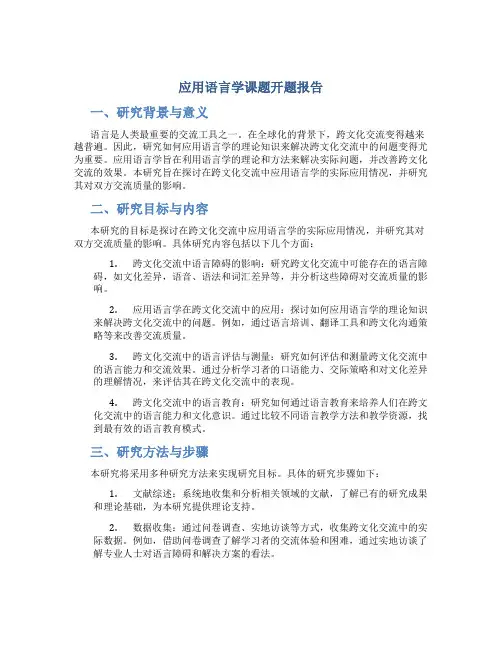
应用语言学课题开题报告一、研究背景与意义语言是人类最重要的交流工具之一。
在全球化的背景下,跨文化交流变得越来越普遍。
因此,研究如何应用语言学的理论知识来解决跨文化交流中的问题变得尤为重要。
应用语言学旨在利用语言学的理论和方法来解决实际问题,并改善跨文化交流的效果。
本研究旨在探讨在跨文化交流中应用语言学的实际应用情况,并研究其对双方交流质量的影响。
二、研究目标与内容本研究的目标是探讨在跨文化交流中应用语言学的实际应用情况,并研究其对双方交流质量的影响。
具体研究内容包括以下几个方面:1.跨文化交流中语言障碍的影响:研究跨文化交流中可能存在的语言障碍,如文化差异,语音、语法和词汇差异等,并分析这些障碍对交流质量的影响。
2.应用语言学在跨文化交流中的应用:探讨如何应用语言学的理论知识来解决跨文化交流中的问题。
例如,通过语言培训、翻译工具和跨文化沟通策略等来改善交流质量。
3.跨文化交流中的语言评估与测量:研究如何评估和测量跨文化交流中的语言能力和交流效果。
通过分析学习者的口语能力、交际策略和对文化差异的理解情况,来评估其在跨文化交流中的表现。
4.跨文化交流中的语言教育:研究如何通过语言教育来培养人们在跨文化交流中的语言能力和文化意识。
通过比较不同语言教学方法和教学资源,找到最有效的语言教育模式。
三、研究方法与步骤本研究将采用多种研究方法来实现研究目标。
具体的研究步骤如下:1.文献综述:系统地收集和分析相关领域的文献,了解已有的研究成果和理论基础,为本研究提供理论支持。
2.数据收集:通过问卷调查、实地访谈等方式,收集跨文化交流中的实际数据。
例如,借助问卷调查了解学习者的交流体验和困难,通过实地访谈了解专业人士对语言障碍和解决方案的看法。
3.数据分析:对收集到的数据进行系统分析和统计处理。
使用合适的统计方法,分析语言障碍和应用语言学解决方案的关联性,以及其对交流质量的影响。
4.结果讨论与总结:根据数据分析的结果,讨论应用语言学在跨文化交流中的实际应用情况,并探讨其对双方交流质量的影响。
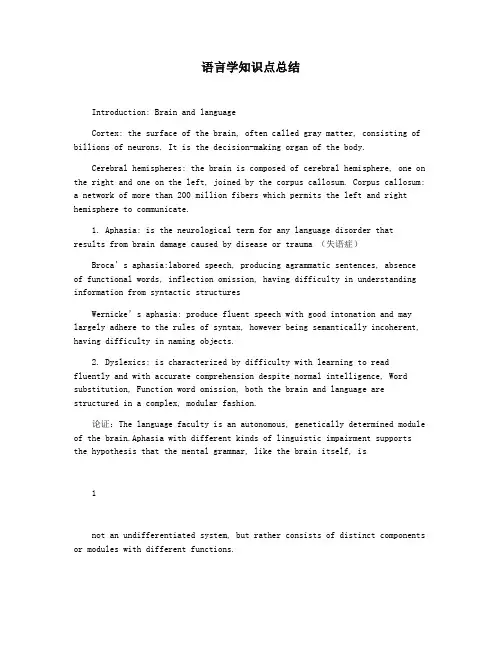
语言学知识点总结Introduction: Brain and languageCortex: the surface of the brain, often called gray matter, consisting of billions of neurons. It is the decision-making organ of the body.Cerebral hemispheres: the brain is composed of cerebral hemisphere, one on the right and one on the left, joined by the corpus callosum. Corpus callosum: a network of more than 200 million fibers which permits the left and right hemisphere to communicate.1. Aphasia: is the neurological term for any language disorder thatresults from brain damage caused by disease or trauma (失语症)Broca’s aphasia:labored speech, producing agrammatic sentences, absence of functional words, inflection omission, having difficulty in understanding information from syntactic structuresWernicke’s aphasia: produce fluent speech with good intonation and may largely adhere to the rules of syntax, however being semantically incoherent, having difficulty in naming objects.2. Dyslexics: is characterized by difficulty with learning to readfluently and with accurate comprehension despite normal intelligence, Word substitution, Function word omission, both the brain and language are structured in a complex, modular fashion.论证:The language faculty is an autonomous, genetically determined module of the brain.Aphasia with different kinds of linguistic impairment supports the hypothesis that the mental grammar, like the brain itself, is1not an undifferentiated system, but rather consists of distinct components or modules with different functions.3. Split brain shows that the two hemispheres appear to be independent,and messages sent to the brain result in different responses, depending on which side receives the message.? Information of language can not be transferred to right hemisphere ? Different hemisphere has different jobs ? Have different visual fields 4. SLI: specific language impairment? Only linguistic ability is affected, and often only specific aspects of grammar are impaired? the different components of language (phonology, syntax, lexicon) can be selectively impaired or spared5. Savant on language: linguistic ability derives from generalintelligence because these two individuals (and others like them) developed language despite other pervasive intellectual deficits.6. The critical-age hypothesis assumes that language is biologically based and that the ability to learn a native language develops within a fixed period, from birth to middle childhood. During this critical period, language acquisition proceeds easily, swiftly, and without external intervention. After this period, the acquisition of grammar is difficult and, for most individuals, never fully achieved.2Morphology: the words of language1. Morpheme:is the linguistic term for the most elemental unit of grammatical form.2. linguistic sign: A morpheme―the minimal linguistic unit―is thus an arbitrary union of a sound and a meaning (or grammatical function) that cannot be further analyzed.3. Root:Morphologically complex words consist of a morpheme root and oneor more affixes. A root may or may not stand alone as a word. The rootconstitutes the core of the word and carries the major components of its meaning.4. Stem:When a root morpheme is combined with an affix, it forms a stem.5. Base:Linguists sometimes use the word base to mean any root or stem to which an affix is attached. Base can be a root or stem. Ⅰ.Classification of Morphemes:Free vs. bound morphemes. Free morphemes: may constitute words by themselves. Free morpheme can stand alone as a word.bound morphemes are other morphemes like �Cness, -ly, pre- are neverwords by themselves but are always parts of words. Bound morpheme must be attached to a base morpheme. bound morpheme: affix, bound root.3Affix:Prefix, Suffix, Infix, Circumfix, Derivational affixes.Infixes:morphemes that are inserted into other morphemes. -um-in Bontonc, kilad,kumilad as \Circumfixes: morphemes that are attached to a base morpheme both initially and finally.. In Chickasaw, the negative is formed with both a prefix ik- and the suffix -o.ik+o in Chickasaw, palli is \Ⅱ.Rules of Word Formation;Derivation, Inflection, compound 1.Derivation: When certain bound morphemes are added to a base, a new word with a new meaning is derived.The form that results from the addition of a derivational morpheme is called a derivedword.The derived word may also be of a different grammatical class than the original word.Sometimes it changes its pronunciation.e.g.-ish,-er,-ly,-ship,re-,un-. 2. Inflection: bound morphemes which have a strictly grammatical function, mark properties such as tense, number, person.inflections never change the grammatical category of the stems. E.g. -s,- ed, -ing, -en, -s,- 's, -er, -est. base+affix e.g.wait-waitsInternal change: ablaut(元音交替) and umlaut(元音变音) in English.e.g.Sing~sang~sung; foot~feet SuppetionReduplication(红红火火) Tone placement43. compound words :Two or more words may be joined to form new, such as steamboat, airplane,redhead, blackboard, redneck, turncoat, highbrow.Head: the morpheme that determines the category of entire word. In English, the rightmost word in a compound is the head of the compound. 4. Back formation: a process that creates a new word by removing a real or supposedaffix from another word. resurrection→ resurrect donation → donate peddler→peddle editor → edit5. Cliticization: one word is attached to the other for phonological reasons. E.g. Jean t’aime. (French) Jean likes you. th’ a ngel (old English) the angel6. Conversion/ Zero Derivation implant, import, record, present, contest? Clipping: a polysyllabic word is shortened by deleting one or more syllables, lab, doc, flu, zoo.? Blends: words are created from non-morphemic parts of two words. smog: smoke fog, bit: binary digit7. Acronyms: taking initial letters of words or phases as a word,5感谢您的阅读,祝您生活愉快。
第一章:语言习得和语言教学第一课:第一语言和第二语言第一语言是个人身份的标志,总体水平也高于第二语言。
第二语言可以在不同环境中获得。
外语环境和二语环境,它们的区分主要取决于课堂之外的目的与是否常用。
第一、而与环境和外语环境的对立,取决与目的与在社区中是否常用。
第二、外语环境和二语环境的区分,有时并不像认为的那么简单。
第三、随着科学技术的进步,特别是因特网的普及,二语环境和外语环境的区别可能变得不那么重要。
第二课:语言习得语言习得即指语言习得这一现象,也指对这现象的研究。
第一语言习得研究的是儿童学习母语问题,也称“母语习得”。
第二语言习得包括对母语之外的所有语言的习得研究,研究对象一般是成年人。
语言习得研究中,有两个基本问题:逻辑问题和发展问题。
逻辑问题研究的课题是:语言习得是如何成为可能的?发展问题指的是:语言习得遵循一定的发展顺序和步骤。
第三课:应用语言学科德是应用语言学的早期代表人物之一。
语言教学和第二语言习得仍然是应用语言学的两个重要领域,但是应用语言学的研究范学科。
与应用语言学相对的,是理论语言学。
理论语言学的目的是对语言系统本身进行理论描述,找出其规律。
第四课:语言教学第一语言教学(母语教学)语言教学母语环境中的第二语言教学(或二语教学)第二语言教学对外环境的第二语言教学(外语教学)上图说明第二语言教学在两个层面上出现即广义:第二语言教学是从基本性质角度进行的分类,与第一语言教学相对。
狭义:第二语言教学是从学习环境角度进行的分类,和外语教学相对。
研究重点:学习机制、学习者语言、语言环境和语言习得、学习者个体差异。
第二语言教学研究的重点是教师和教学过程,第二语言习得研究的重点是学习和学习过程,包括中介语。
第五课:教学理念反应的是对语言学习和语言教学的基本认识。
包括:学习什么、怎样学习、如何教授。
理念是从一个人所受的全部语言教育当中,从这个人的语言学习有关的全部经历当中感悟出来的。
比较系统,有比较深厚的理论基础。
应用语言学名词解释应用语言学是语言学的一个分支领域,研究语言在实际应用中的各种现象和问题。
它关注语言的实际使用情况,并试图解释和预测语言使用的规律,以及改进语言的实际应用效果。
下面是一些与应用语言学相关的重要名词的解释。
1. 语言维度(linguistic dimension):指语言的各个方面,包括语法、词汇、语音、语境等。
2. 语用学(pragmatics):研究语言使用中的非字面意义和上下文相关的现象,如指示、暗示、语用推论等。
3. 社会语言学(sociolinguistics):研究语言与社会的关系,包括语言变体、方言、语言规范等现象。
4. 语音学(phonetics):研究语音的音质、音位和音系等方面的学科。
5. 语音分析(speech analysis):运用技术方法对语音进行分析,研究语音的特征和规律。
6. 语言处理(language processing):指人类如何理解和表达语言的过程,也指计算机如何处理和理解语言的问题。
7. 自然语言处理(natural language processing):使计算机能够理解、处理和生成人类语言的技术和方法。
8. 语料库语言学(corpus linguistics):以语料库为基础,运用统计方法研究语言的现象和规律。
9. 语篇分析(discourse analysis):研究语言在实际语境中的使用和组织方式,关注语言与社会、文化、认知等因素的关系。
10. 语境(context):指在特定的交际环境中,语言使用者通过语言实际传递的意义。
11. 二语习得(second language acquisition):指学习第二语言的过程和结果的研究。
12. 交际(communication):指人类通过语言实现信息传递和意义交流的过程。
13. 言语行为(speech act):指通过语言行动来实现特定目的的行为,如请求、命令、承诺等。
14. 修辞学(rhetoric):研究通过语言来实现说服、感染等目的的技巧和方法。
应用语言学
应用语言学是一门探讨语言的应用及实践性的学科,它的研究关注于语言应用的各种问题,从而使之变得更加有效和可操作。
应用语言学研究的范围包括社会语言学、语音学、翻译、语言学习与教学、语言交际与口头传达等。
在应用语言学研究中,会着重研究语言的句法,语义,语用和语文概念,从而揭示不同语言之间的异同。
它可以被用来解释和记录语言变化,以及探讨语言应用的正确方法。
应用语言学的研究方法是参考历史的语言和文本,对于语言的流变和文化的影响来看待它们。
这些研究也可能结合语言学原理,以解决现实语言问题,比如翻译的质量,语言的表达规则等。
应用语言学研究也被用来优化人机交流,多媒体信息的获取,以及语言学习与教学。
应用语言学的研究成果被广泛应用于社会科学、语言训练、信息系统、机器翻译、语音识别、语义理解、自动文本分析和生成等领域。
应用语言学的总体目的是建立一个既能够应用于实践,又能更好地理解语言的系统,以提高语言使用的效率。
应用语言学研究有助于我们更好地了解语言,因此也有助于改善人们的语言表达。
它可以帮助我们正确地使用语言,避免写出不合乎文法规则的句子,以及准确理解别人所表达的意思。
应用语言学也可以为培养语言素养提供强有力的支撑,以便各社会参与者能够更好地沟通。
总之,应用语言学是一个强调实践的学科,它的研究领域对于社会科学领域的发展有着重要的作用。
只有理解语言的本质,我们才能更好地应用语言,并发展新的语言应用技术,以提高人类社会的文明水平。
跨学科对比应用语言学和社会语言学
语言学是研究语言的学科,主要关注语言的结构、意义和使用等方面。
而应用语言学
和社会语言学则是语言学的两个分支,它们分别关注语言在实践中的应用和语言与社会文
化的关系。
应用语言学是研究语言在实践中的应用的学科,主要涉及语用学、教育语言学、计算
语言学等方面。
语用学研究语言的使用和意义,包括语言行为、语境、言外之意等;教育
语言学研究语言教学和学习,包括语言教育政策、教材设计等;计算语言学则关注语言处
理和自然语言理解等方面。
应用语言学的研究对象主要是语言在实践中的运用,例如口语
交际、写作表达、翻译等。
相比之下,社会语言学则更加关注语言与社会文化的关系,研究语言与社会结构、权力、身份认同等因素之间的相互作用。
社会语言学的研究对象主要是语言使用者及其社会
背景、语言使用场景以及语言实践的社会意义等。
社会语言学领域包括口语社会语言学、
次文化语言学、族群语言学等。
应用语言学和社会语言学在研究对象和研究方法上有很多共同点,但也存在一些不同。
应用语言学主要关注语言实践中的应用问题,强调具体的语言行为和实践活动,注重运用
语用学、教育语言学和计算语言学等方法研究。
社会语言学则更加关注语言与社会文化的
关系,强调社会背景、身份认同等因素对语言的影响,注重运用社会学、人类学等方法研究。
综上所述,应用语言学和社会语言学是语言学的两个重要分支,它们分别从不同的角
度研究语言的实践应用和与社会文化的关系,但二者的研究对象和研究方法也存在一些交
叉和共通之处,互为支持和补充。
Chapter 3 summary应用语言学王婷婷13502008Traditionally, metaphors and metonymies have been regarded as figures of speech, however, the two phenomena are powerful cognitive tools for our conceptualization of the world.First, It is common knowledge that words are often used in figurative senses.Even very young children are adept at using figurative language. Nevertheless, the study of this linguistic phenomenon was for a long time the exclusive domain of literary scholars and the odd linguist who was interested in rhetoric or stylistics.They consider that metonymy involves a relation of contiguity between what is denoted by the literal meaning of a word and its figurative counterpart and that one constituent of the metonymic link stands for the other. In contrast, metaphor has traditionally been based on the notions similarity or comparison between the literal and the figurative meaning of an expression.They also take some examples to show that metaphor and metonymy are not just figures of speech in literature but also pervasive in everyday language. Next, in tracing the development from the traditional to a cognitive conception of metaphor and metonymy, we have already recognized by Black in a precognitive context, metaphors act as cognitive instruments.This means that metaphors are not just a stylistically attractive way of expressing ideas by means of language, but a way of thinking about things. In addition, metonymies are also more straightforwards than metaphors: their major goal is to refer to an entity, prototypically a person, denoted by the target concept by means of the source concept.Second, in the cognitive linguist’s views, the structure of emotion concepts are reflected in metonymic and metaphorical expressions. They find that the link between emotions and physiological symptoms reminds us of certain metonymic mappings,especially the cause-effect relationship observed in metonymies. They also single out three aspects that between them illustrate both the potential and the limitations of physiologicalmetonymies. There are indeed bodily symptoms which seem to be helpful for a description of the conceptual structure of emotions because they are peculiar to one particular emotion. They find that our preference depends on the situation, perhaps on the individual person, or it could also be a matter of sequence, perhaps on the individual person, or it could also be a matter of sequence, with a state of paralysis functioning as a preface to flight. At last, problems is that may metonymies apply not just to one or a few closely related emotions, but to a range of quite different emotions.Third, When metaphors as a way of thinking, they can be used to structure concepts underlying certain abstract words, and it should not show up in the way we approach the complex scientific, political and social issues of our world. Langacker realizes that metaphor is a powerful explanatory tool which cannot be defeated by only offering an abstract alternative explanation in terms of compositionality and analyzability, such as we use +SCAFFOLDING+ metaphor to explain newspaper, which means you can take out the attributes of news, just use paper, just like the function of scaffolding. In science, for example, we can use solar system to explain atom, which could be understood more clearly. In politics, the natural force concepts like WIND can be reflected in the abundant ‘wind-of-change’speeches. Popular political thinking largely depends on constitutive metaphors, which are often consciously created and fostered by politicians and propagandists.Fourth, just like metaphors, metonymies can be understood as a way of thinking and metonymy is considered a cognitive process underlying linguistic phenomena and motivating them. Possessive compounds, noun-verb conversations and even conventionalized speech acts were shown to be at least describable in terms of metonymic mappings, but the success of any metonymy depends on the availability of a cognitive model or some other kind of conceptual background serving as a mapping scope accessible to the language user.。
应用语言学应用语言学语言学是研究人类语言的科学,它研究语言的形态、功能和结构以及语言的演化、使用和习得等方面。
作为一门学科,语言学在实际应用中发挥着重要的作用。
下面将介绍一些应用语言学的领域和案例。
1. 语音识别与语音合成语音识别技术将语音转化为文本,广泛应用于语音助手、语音搜索和语音输入等领域。
它可以帮助人们更快捷地获取信息并实现智能化交互。
语音合成技术则将文本转化为语音,应用于朗读系统、电子书和自动语音导航等领域。
2. 机器翻译机器翻译是指利用计算机技术将一种语言的文本转化为另一种语言的文本。
它可以帮助人们在跨语言交流中消除语言障碍,提高交流效率。
机器翻译技术已经广泛应用于文档翻译、实时翻译和语音翻译等领域。
3. 文本挖掘与情感分析文本挖掘技术利用自然语言处理和机器学习技术分析大规模文本数据,从中提取有用的信息和知识。
情感分析则是识别和理解文本中的情感信息。
这些技术可以应用于社交媒体监测、品牌声誉管理和舆情分析等领域。
4. 自然语言处理自然语言处理是指将人类语言转化为计算机能够理解和处理的形式。
它涉及到词法分析、句法分析、语义分析和语篇分析等技术。
自然语言处理技术可以用于问答系统、信息检索和智能客服等领域,提供自动化的语言处理服务。
5. 语言教育与辅助学习语言教育是语言学中一个重要的应用领域。
通过语言学的研究成果,可以为语言学习者提供更科学和有效的学习方法和工具。
例如,利用自然语言处理技术开发的语法纠错系统和语言学习APP可以帮助学生改善语言技能。
6. 社会语言学与语料库语言学社会语言学研究社会和文化对语言使用的影响,以及不同社会群体之间的语言差异。
语料库语言学则利用大规模的语言样本进行语言学研究,通过分析语料库中的语言数据,揭示语言的变化和演变规律。
在以上的应用领域中,语言学与计算机科学、人工智能、数据挖掘等多个学科交叉融合,为实现自然语言处理和人机交互提供了重要的基础。
随着技术的不断进步和应用的推广,语言学在各个领域中的应用将会变得更加广泛和深入。
名词解释
1. 个别语言学:属于本体语言学,是探讨一种语言的结构和发展规律。如:汉语语言学,
英语语言学。
普通语言学:是研究人类语言一般的性质和普遍的性质及普遍的结构规律的学科。由于
讨论的是对各种具体语言有普遍指导意义的理论,又被称为理论语言学。
2. 共时语言学:又称“描写语言学”,是指选取语言的某一个历史阶段,描写这个阶段的
语言的状态。如:现代汉语、先秦汉语。
历时语言学:又称“历史语言学”,它研究语言的发展变化。如:汉语史。
3. 自然语言处理:是运用计算机技术来研究、处理自然语言的交叉性学科。主要目标是让
计算机懂得和理解人的自然语言,实现人机对话。
中文信息处理:是自然语言信息处理的下位概念,是指用计算机对中文进行存储、转
换、分析、传输等加工,以形成各种信息处理系统的科学。
4. 语言能力:传统上指运用语言进行听说读写的能力或指用书面或口语进行交际的能力。
(如:语音能力、词汇能力、语法能力。)从而规范地、正确地使用语言。
语言交际能力:说话者适应交际主体、主旨、语境,有效地进行言语交际的能力。即更
加得体、有效地使用语言的能力。
5. 对比分析:就是把两种或两种以上的语言或方言进行共时对比,描述他们之间的异同。
目的是由此找出目标语学习者的学习难点,以便于最有效的方法来组织教学。
偏误分析:指对学生在第二语言学习中所产生的偏误进行分析,进而研究第二语言的学
习过程。它是研究学习过程的捷径,也是研究学习过程的第一步。
简答题
1.语言学和其他学科的联系导致一系列新兴的交叉学科的建立,主要是有哪些?
(1).社会语言学:用社会学的方法研究社会上的各种语言变异等问题。
(2).人类语言学:研究语言所反映的民族文化及其演变情况。
(3).心理语言学:研究语言行为和心理过程之间的关系。
(4).数理语言学:用代数,计算机科学,统计等领域中国的概念和方法研究语言的数学属
性等问题。
(5).实验语言学:用各种实验仪器分析语音,研究语音的识别和合成等问题。
(6).计算语言学:用计算机科学的技术和概念研究语音,特别是研究语言的理解和处理,
机器翻译,情报检索等问题。
2.应用语言学的主要特点?
答.(1)具有学科的相对独立性。在较长时间里,人们认为它是理论语言学的一部分,现在
的趋势是将二者分开,让其成为独立学科,有理论数学-应用数学,理论化学-应用化学,理
论物理学-应用物理学的区分;它有明确的研究任务,研究语言学在一切领域的实际应用问
题,有明确的研究对象,有几个成熟的下位领域。
(2)有实用性。要解决语言学在各个应用领域中的实际问题,是为了直接满足语言学在社
会生活中的实际需求。
(3)实验性。离不开调查和试验,具有自然学科的特点。调查法和试验法是应用语言学研
究的两个重要方法。统计法十分常用软件。国家课题。
(4)综合性(边缘性)要和几个学科相结合。那个时候学科应用到语言和语言学,他就要
涉及哪个学科。应用语言学形成许多分支。
3.应用语言学的主要内容?
(1).是广义的社会语言学,研究语言本体和本体语言学同社会的关系。(2).是语言规划
(3)是语言教学(4)是语言本体和本体语言学同现代科技的关系,例如计算机语言学。
4.语言教学包括哪几个阶段?
(1)政府:政策支持(是否教,教什么,教谁)
(2)语言学家:制定教学大纲,编教材(教什么,何时教,教多少)
(3)教师:怎样教,语言教学的方法体系
(4)学生:怎样学
7.中文信息处理的三大难关?
○1字处理,汉字在输入,输出,存储
○2词处理,自动分词,自动词性标示。汉语是孤立语,没有太多的形态变化,不像英语俄语
有丰富的形态变化,能够使计算机识别词的词性,且拼音文字在书写时会词词分开,而中文
则为连写,计算机在识别时会出现困难。
○3句处理,在使计算机理解和生成句子时会出现困难。
8中西方语言的差异对中文信息处理产生的影响,为什么?
答:首先,中西方的文字不同,中文是语素文字,英语等是拼音文字,那么在输入,输出方
面我们难以借鉴西方经验,使如何让汉语输入计算机成为一个难点。再者,汉语的词与英文
的词有很大差异,英语等语言在书写时词词分明,而中文是连写,是计算机在断句方面会出
现困难。中西方在语言形态方面有很大差异,汉语是孤立语,英文等是屈折语,汉语没有丰
富的形态变化,英语有,英语的变化可以体现在文字上,减轻了计算机的困难。
9自然语言处理的出现有什么重大意义?
自然语言信息处理的出现,使得语言学在现代科学体系中的地位有了明显变化,使得语言学
由一门基础学科变成领先科学。获得了与数学哲学同等的地位,语言学将成为人文科学发展
的突破点和生长点,它的重要意义已经为越来越多的人认识。
10语言的动态性,从宏观上变现为随着社会的发展而发展,为什么?
答:从宏观上来看,语言会随着社会的变化而变化。首先,语言会随着社会的分化而分化,
这种分化会出现会出现地域方言和社会方言。其次,社会的统一会造成语言的统一,具体变
现为共同语,最后,语言的接触会形成语言的融合,进一步形成特殊语言交际形式,如,皮
软语,克里奥尔语。
12.举例说明语言中的文化现象。
1.从词源当中可以探查古代文化遗迹
①英语中pen--penna源于拉丁语是羽毛得意思②藏语中“gui”有银子和钱两个意思(古代
用银子作为货币)
2.从造词的心理可以窥测古代的社会风貌
①中国云南独龙族 /dzio/可表示麻布,衣服,被子三个意思,社会生产力低下一物三用②
女权运动中,history--hertory chairman--chairperson
3.从词语的对比可以观察民族文化的差异
①汉英对亲属关系的区分:汉语中对舅舅叔叔伯父的称谓不同,但英语中都用uncle表示。
②汉语:夫妻,公婆,子女体现了男尊女卑
但云南丽江纳西族罗梭人则相反(以前是母系社会)
同义词:母--大 公--小 大树--树母 小树--树男
4.从借词可以了解各个民族之间文化交流
茶:在英法德中音都为“tea”与福建厦门话的茶读音相近。俄,日都音“茶”,与北方话接
近
(说明:中国的“茶”从两条路传出去,一条由福建沿海运往西欧,一条由华北运往俄国日
本)
13.中介语的主要特点
1.系统性:指学生在使用目标语时虽然会出错误,会与目标语系统有差距,但仍然依照一定的
规则,而不是任意的。
2.动态性:指中介语系统不管在什么时候都是不固定的,都可进行改变和完善,他们总是随着
时间的推移而不断地演变和发展
3.顽固性:中介语在向目标语靠拢的过程中不是直线型的,有的错误虽然得到了纠正但是仍然
会重新出现。
4.能动性:主要指第二语言的学习者在学习第二语言过程中所表现出来的创造性。
14.举例说明偏误的来源
1.第一语言的干扰,在中文中没有第三人称单数,会忘记加"s,es"
2.第二语言规则的过渡泛化。如,你等等我一下,由一个星期会说成一个年,一个天
3.学习语境的影响。老师:你眉毛画的很好 留学生:你胡说! 胡说表示否定,不满。
4.学生交际策略与学习策略的影响。如,请给我你的笔。(请把你的笔给我)留学生把字句
用的不好,所以会回避把字句的使用
5.文化迁移。有一个叫张大年的先生。会说成,有一个叫年大张的先生。
15.对比分析的局限性
不以学生为出发点,不通过分析学生对第二语言的实际使用来预测学习的难易,这就造成预
测的不准确,有一些真正的难点对比分析并没有预测到。
论述题
16
17
8.
(作业)
我国从新中国成立以来,在全国推广普通话,但方言还是大量存在,方言和普通话“同中有
异,异中有同”。普通话的标准虽然只有一个,但是在标准普通话和方言之间却有很大的过
渡地带存在,我们把这一过渡地带中的普通话称为方言普通话或地方普通话,这就有了方言,
地方普通话和普通话三个层次。地方普通话主要是由普通话和方言集合而成的,到这种集合
并不是简单的混合,而是有特定的规律。它又可以分为好的,较好的和较差的等不同层次,
这些不同层次的地方普通话都可以称为过渡语。随着普通话水平的提高,它们都在向普通话
靠拢:好的向标准普通话靠拢,较差的和较好的向好的靠拢,正确认识这个“过渡地带”直
接影响到“推普”工作,也影响到我国的语言规范化工作。
19与传统语言学相比,计算语言学的特点
一,元语言的形式化,元语言是和对象语言想对而言的,元语言指的是研究者在研究描述对
象语言时所使用的语言。
二,具有可操作性,操作性是与描述性相对而言的,操作性告诉人们怎样从一个现成的句子
变成它的句法结构乃至得出它的意义。
三,具有工程性,工程性是相对理论性而言的,
四,注重语言研究的全局性和一般性,计算机语言学重视把语言作为一个整体来研究,更注
重从全局出发,研究计算机处理语言的普遍性和一般性问题。